
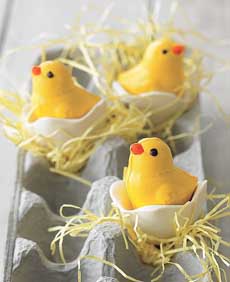 Peep at these candy chicks from WilliamsSonoma.com. Read our recommendations of more top Easter candy. Peep at these candy chicks from WilliamsSonoma.com. Read our recommendations of more top Easter candy.

April 2007
|
 |

April 2007
Gourmet News & Views
Trends, Products & Items Of Note In The World Of Specialty Foods
Gourmet News is published by 11 a.m. each Monday.
To send news releases, see below.
- Click here for the news archives.
- You can receive the news via RSS by clicking on the RSS box above.
- You also can receive a weekly e-mail with links to this page by subscribing to the News Feed.

4.30.07
News
Illy Opens First Caffè. Italian coffee chain Illy, whose high-end beans have been 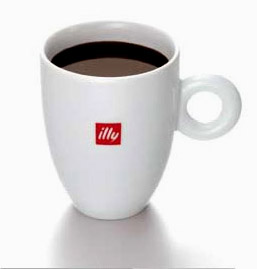 enjoyed by consumers and served at hotels and restaurants around the country for years, has opened its first U.S. café, in the District of Columbia. Named simply Caffè, the Italian spelling for coffee and café, the shop opened last week in Marriott’s Renaissance M Street Hotel. It features sleek red-and-white decor and the chain’s signature ceramic espresso cup. There are no tables, only a stand-up bar on which patrons can rest an elbow, European-style. Starbuck’s may not be quaking yet, but in terms of the taste of the coffee and espresso, the ambience, and the option, we look forward to more red and white Caffès mushrooming around the country. enjoyed by consumers and served at hotels and restaurants around the country for years, has opened its first U.S. café, in the District of Columbia. Named simply Caffè, the Italian spelling for coffee and café, the shop opened last week in Marriott’s Renaissance M Street Hotel. It features sleek red-and-white decor and the chain’s signature ceramic espresso cup. There are no tables, only a stand-up bar on which patrons can rest an elbow, European-style. Starbuck’s may not be quaking yet, but in terms of the taste of the coffee and espresso, the ambience, and the option, we look forward to more red and white Caffès mushrooming around the country.
Water Follies. As reported on Charleston.net in a review of Thirst: Fighting the Corporate Theft of Our Water, by Alan Snitow and Deborah Kaufman with Michael Fox: It doesn’t pay to dis Cleveland, even in jest. The authors write of a Fiji Water ad campaign that boasted of the water’s purity and ended with, “The label says Fiji because it’s not bottled in Cleveland.” This snub to the Cleveland water supply didn’t sit well with Cleveland officials. The Fiji water was analyzed and found to contain more arsenic than was allowed in Cleveland’s municipal water supply. A Cleveland television station followed up with a blind taste test, in 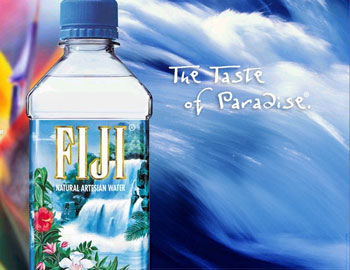 which participants chose their tap water over Fiji. (In fact, despite the $11 billion spent annually on bottled water, tap water wins most of the time in taste tests nationwide.) Study after study has concluded that bottled water is neither cleaner nor greener than tap water. “The Natural Resources Defense Council discovered that a surprising number of the bottled waters they tested contained contaminants, pesticide residues and heavy metals,” the authors write. They point out that the Environmental Protection Agency imposes and enforces rigid standards for municipal tap water, while the Food and Drug Administration, which oversees bottled water, pays more attention to what’s on the labels of the bottles than what’s in the water inside. However, the real issue raised by the activists and the authors is bigger than just bottled water versus tap water. The book addresses recent water fights in Wisconsin and Michigan to prevent Switzerland-based Nestlé Corp., the owner of Perrier, San Pellegrino, Aqua Panna, Vittel, Contrex and several other bottled-water companies, from opening plants in their areas to siphon out millions of gallons of water and transport it out of the locale for sale elsewhere. “Water that is used in cities and in agriculture inside the watershed flows back into the water table. Once diverted outside the watershed, it does not return to the aquifers, streams and rivers that replenish the lakes,” the authors write. They are challenging the notion that a common resource as vital as water should be allowed to come under the control of giant multinational corporations driven solely by profit. They see the possibility of water becoming the oil of the 21st century in terms of pricing and availability if control, of it is ceded to big companies. which participants chose their tap water over Fiji. (In fact, despite the $11 billion spent annually on bottled water, tap water wins most of the time in taste tests nationwide.) Study after study has concluded that bottled water is neither cleaner nor greener than tap water. “The Natural Resources Defense Council discovered that a surprising number of the bottled waters they tested contained contaminants, pesticide residues and heavy metals,” the authors write. They point out that the Environmental Protection Agency imposes and enforces rigid standards for municipal tap water, while the Food and Drug Administration, which oversees bottled water, pays more attention to what’s on the labels of the bottles than what’s in the water inside. However, the real issue raised by the activists and the authors is bigger than just bottled water versus tap water. The book addresses recent water fights in Wisconsin and Michigan to prevent Switzerland-based Nestlé Corp., the owner of Perrier, San Pellegrino, Aqua Panna, Vittel, Contrex and several other bottled-water companies, from opening plants in their areas to siphon out millions of gallons of water and transport it out of the locale for sale elsewhere. “Water that is used in cities and in agriculture inside the watershed flows back into the water table. Once diverted outside the watershed, it does not return to the aquifers, streams and rivers that replenish the lakes,” the authors write. They are challenging the notion that a common resource as vital as water should be allowed to come under the control of giant multinational corporations driven solely by profit. They see the possibility of water becoming the oil of the 21st century in terms of pricing and availability if control, of it is ceded to big companies.
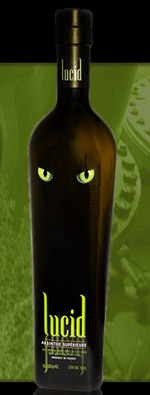 Product Watch Product Watch
Absinthe Returns. Remember absinthe—at least, do you remember reading how artists and writers of the 19th century would sip the anise-flavored liqueur as their libation of choice? It hasn’t been legal in the U.S. since Prohibition because of thujone, a potentially toxic compound that added to the myth that absinthe fueled the fires of creativity, caused hallucinations and in cases of excess consumption, led to madness. While there have been faux absinthe products on the market and people smuggle in an occasional bottle from Europe, an artisan distiller has reclaimed the right of Americans to enjoy grande wormwood (Artemisia absinthium)-based absinthe. While there is no law that prohibits absinthe by name, any drink that contains in excess of 10ppm of thujone is prohibited from being imported into, or produced for sale and consumption in, the U.S. No regulations have changed, but a greater understanding of the method of thujone analysis and an understanding of exactly how much of the substance was in absinthe led to a major breakthrough. It also meant that a number of pre-ban era absinthes would have been legal in the U.S. by modern standards, including the definitive premium absinthe brand, Pernod Fils. (For more information, see WormwoodSociety.org.)
Viridian Spirits of Manhasset, New York has re-created a fine Belle Époque absinthe in antique copper stills. Named Lucid, the first true absinthe made and sold in the U.S. since prohibition (it’s packaged in a bottle that looks strangely like the feline used as the visual for the musical “Cats”). The liqueur is distilled in New York State entirely from spirits and traditional absinthe herbs like green anise and sweet fennel. The 124-proof liqueur will be available in May, priced at $59.95 for a 750-milliliter bottle. For more information visit DrinkLucid.com.
Trends
Flatbreads On The Rise. Flatbreads are hot according to Stagnito’s New Products Report, a trade magazine and e-zine that reports on food industry happenings and 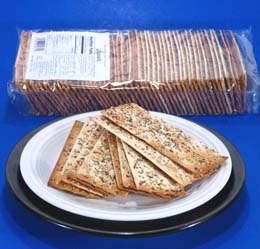 trends. Consumers are increasingly interested in flatbreads, similar to a pocketless pita and typically made from flattened dough. Flatbreads are the oldest breads on earth—they preceed leavening agents, which enable bread to rise. Today, there are unleavened flatbreads (crepes, tortillas, arepas, pita) as well as chewy leavened varieties (baladi, bruschetta, ciabatta, dosai, focaccia, inerja, mafrood, naan, pane carasau, piadine, pizza, tanoor)—there are about 60 different flatbreads made worldwide. So while it’s not exactly a global trend, domesticaly, new products with the name “flatbread” more than tripled to 66 last year from 20 in 2005, the most recent data available, according to research firm Mintel. A product that used to be found in specialty food and ethnic markets and restaurants has gone mainstream. Quiznos is including flatbread with much of its salad line to flatbread. Dunkin’ Donuts is testing flatbread sandwiches. Arby’s is promoting flatbread melts. And Stouffer’s, the maker of upscale frozen and microwavable foods, is rolling out a line of fancy-sounding flatbread pizzas. Flatbread often carries an upscale price. Stouffer’s flatbread at $3.99 ranks among its most expensive meals. Photo courtesy of CheeseSupply.com. trends. Consumers are increasingly interested in flatbreads, similar to a pocketless pita and typically made from flattened dough. Flatbreads are the oldest breads on earth—they preceed leavening agents, which enable bread to rise. Today, there are unleavened flatbreads (crepes, tortillas, arepas, pita) as well as chewy leavened varieties (baladi, bruschetta, ciabatta, dosai, focaccia, inerja, mafrood, naan, pane carasau, piadine, pizza, tanoor)—there are about 60 different flatbreads made worldwide. So while it’s not exactly a global trend, domesticaly, new products with the name “flatbread” more than tripled to 66 last year from 20 in 2005, the most recent data available, according to research firm Mintel. A product that used to be found in specialty food and ethnic markets and restaurants has gone mainstream. Quiznos is including flatbread with much of its salad line to flatbread. Dunkin’ Donuts is testing flatbread sandwiches. Arby’s is promoting flatbread melts. And Stouffer’s, the maker of upscale frozen and microwavable foods, is rolling out a line of fancy-sounding flatbread pizzas. Flatbread often carries an upscale price. Stouffer’s flatbread at $3.99 ranks among its most expensive meals. Photo courtesy of CheeseSupply.com.
Fishing For Solutions. The New England cod fishing industry is pretty much done for: dwindling schools of cod. Blue fin tuna are severely overfished. Swordfish and monkfish: iffy. Many of the fish we enjoy every day are endangered or not sustainable (produced in an environmentally harmful way). There are too many people who want to eat fish, and not enough fish to supply demand. A study published last fall in the journal, Science, warned of a “global collapse” of all wild seafood by mid-century if fishing continues at its current pace. Atlantic salmon is farmed because there’s no wild Atlantic salmon left, but farming can pollute oceans. Catfish and tilapia are good choices: They’re farmed in closed ponds that don’t pollute the ocean. Bay scallops, farmed or wild, are said to be a sustainable resource. Wild salmon from Alaska come from a well-managed fishery. But Less than 10 percent of the world’s catch is currently certified as sustainable. The Marine Stewardship Council, or MSC, was started by Unilever and the World Wildlife Federation to set a global standard for well-managed fisheries at the corporate level, to guide retailers and restaurant chains. In terms of what you can do to make sustainable choices, visit SeafoodWatch.org.

4.23.07
News
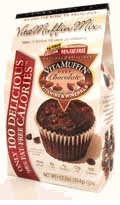 Vitalicious Deep Chocolate VitaMuffin Mix Named “Best Muffin.” A previous NIBBLE pick, Vitalicious™ Food’s Deep Chocolate VitaMuffin Mix, has been selected for Health Magazine’s 2007 Best of Food Awards, a roundup of the 24 best and healthiest new foods for busy women. Easy to bake at home, each muffin has just 100 calories, is 98% fat-free, and contains 6 grams of fiber, 4 grams of protein, soy fiber and 15 essential vitamins and minerals. The winners were chosen from more than 500 food items that were introduced in 2007. Read our full review of VitaMuffin Mixes. Vitalicious Deep Chocolate VitaMuffin Mix Named “Best Muffin.” A previous NIBBLE pick, Vitalicious™ Food’s Deep Chocolate VitaMuffin Mix, has been selected for Health Magazine’s 2007 Best of Food Awards, a roundup of the 24 best and healthiest new foods for busy women. Easy to bake at home, each muffin has just 100 calories, is 98% fat-free, and contains 6 grams of fiber, 4 grams of protein, soy fiber and 15 essential vitamins and minerals. The winners were chosen from more than 500 food items that were introduced in 2007. Read our full review of VitaMuffin Mixes.
Product Watch
Ben & Jerry’s Introduces Fair Trade Ice Cream. Two ice cream “firsts” in one month! Earlier this month we published a review of the first single origin chocolate and 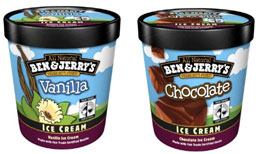 vanilla ice creams from Choctál and Häagen-Dazs. Now, you can buy Fair Trade Certified™ Vanilla & Fair Trade Certified™ Chocolate. The company has revamped its two best-selling flavors with Fair Trade Certified cocoa powder and vanilla extract. The Fair Trade Certified program benefits farmers by directly paying them more for their products and encourages farmers to work cooperatively to succeed together. Ben and Jerry’s had previously introduced Fair Trade Certified Coffee and Coffee Coffee Buzz Buzz Buzz ice creams. The new flavors debuted along Cinnamon Buns™, caramel ice cream with cinnamon bun dough and a caramel streusel swirl—which should be popular even without a Fair Trade certification. vanilla ice creams from Choctál and Häagen-Dazs. Now, you can buy Fair Trade Certified™ Vanilla & Fair Trade Certified™ Chocolate. The company has revamped its two best-selling flavors with Fair Trade Certified cocoa powder and vanilla extract. The Fair Trade Certified program benefits farmers by directly paying them more for their products and encourages farmers to work cooperatively to succeed together. Ben and Jerry’s had previously introduced Fair Trade Certified Coffee and Coffee Coffee Buzz Buzz Buzz ice creams. The new flavors debuted along Cinnamon Buns™, caramel ice cream with cinnamon bun dough and a caramel streusel swirl—which should be popular even without a Fair Trade certification.
Boursin Family Grows. Those whose first “gourmet” cheeses included French import Boursin will be glad to know of new additions to the family: Fig, Raisin & Nut Boursin and Shallot & Chive Boursin. Boursin was created in 1957 by François Boursin, 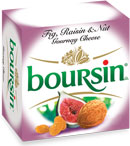 a cheesemaker in Normandy, France. His first variety, Boursin Garlic & Fine Herbs, was inspired by a traditional dish, fromage frais (fresh cheese, from cow’s milk), served with a bowl of fine herbs, which allowed each person to create his or her own personally seasoned cheese. Boursin Garlic & Fine Herbs was the first flavored fresh cheese to be sold throughout France, and was soon followed by Boursin Pepper. There’s also a Boursin Light Garlic & Fine Herbs. The brand has been owned by Unilever since 1989, and is sold in 35 countries on five continents. a cheesemaker in Normandy, France. His first variety, Boursin Garlic & Fine Herbs, was inspired by a traditional dish, fromage frais (fresh cheese, from cow’s milk), served with a bowl of fine herbs, which allowed each person to create his or her own personally seasoned cheese. Boursin Garlic & Fine Herbs was the first flavored fresh cheese to be sold throughout France, and was soon followed by Boursin Pepper. There’s also a Boursin Light Garlic & Fine Herbs. The brand has been owned by Unilever since 1989, and is sold in 35 countries on five continents.
Roasted Red Pepper Chips Return. Market prices have started down to drop, 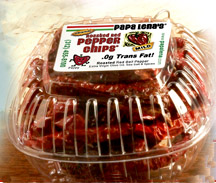 engendering the return of Papa Lena’s wonderful red pepper chips. Read or review, and order yours before the limited quantities disappear. Made by an artisan team in Chicago, they are roasted in olive oil and are more glorious than any vegetable chip you’ve ever had. We like them as snacks as well as plate garnish: They make lunch and dinner plates, soups and salads look very glamorous. The other vegetable are delicious too: click on the link to read our review. engendering the return of Papa Lena’s wonderful red pepper chips. Read or review, and order yours before the limited quantities disappear. Made by an artisan team in Chicago, they are roasted in olive oil and are more glorious than any vegetable chip you’ve ever had. We like them as snacks as well as plate garnish: They make lunch and dinner plates, soups and salads look very glamorous. The other vegetable are delicious too: click on the link to read our review.
Bumble Bee: Bad Buzz. In 2005 G’Day Gourmet, our favorite marinated tuna line, arrived on these shores from Australia; since then StarKist and Bumble Bee have both rolled out marinated, canned tunas. StarKist sells Gourmet Choice Yellowfin Marinated Tuna Fillet in 5.5-ounce cans, in extra virgin olive oil and Lemon Dill or Roast Garlic seasonings. It is delicious—and OU kosher, too.* Bumble Bee’s Chunk Light Tuna “Touch of Lemon” in water (also OU) just can’t compare: It looks unattractive (no “chunks,” just a wet pile of individual flakes—i.e., cat food) and the lemon juice and natural lemon flavor cited on the label have the net effect of a splash of reconstituted lemon juice. One would do far better to purchase a superior canned tuna and squeeze fresh lemon onto it—or, buy the yummy StarKist product. We also tasted Bumble Bee Sensations™ Tuna Medleys and wish we had stopped at “Touch of Lemon.” The line comes in snack-size 3-ounce cans (like G’Day Gourmet, but packaged with Ritz-type crackers and a small plastic spoon) and in 5-ounce peel-top cans. Thank goodness we opted for the smaller portions. We took a bite of Spicy Thai Chili—which looked almost exactly like G’Day Gourmet’s Chili, down to the tiny chili included in the can—and the 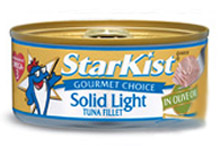 first taste was a mouthful of sugar! Yes, folks, there’s sugar in the can of tuna—in all three flavors, in fact, although the lemon juice and pepper in the Lemon & Cracked Pepper flavor cover it up. The Sundried Tomato & Basil tastes like Tuna and Candied Tomatoes—dreadful. Recently, a trade columnist opined, with respect to the national obesity and diabetes problems, that sugar was not the enemy—the problem lay with Americans who choose to eat too much sugar in their diets. We responded that he neglected to name food manufacturers who insist on adding sugar to products where they don’t belong—in bread, salad dressing, soup, pasta sauce, etc. You have to carefully read supermarket labels to find a savory product that doesn’t have sugar in it. And now tuna? Why, Bumble Bee, why? first taste was a mouthful of sugar! Yes, folks, there’s sugar in the can of tuna—in all three flavors, in fact, although the lemon juice and pepper in the Lemon & Cracked Pepper flavor cover it up. The Sundried Tomato & Basil tastes like Tuna and Candied Tomatoes—dreadful. Recently, a trade columnist opined, with respect to the national obesity and diabetes problems, that sugar was not the enemy—the problem lay with Americans who choose to eat too much sugar in their diets. We responded that he neglected to name food manufacturers who insist on adding sugar to products where they don’t belong—in bread, salad dressing, soup, pasta sauce, etc. You have to carefully read supermarket labels to find a savory product that doesn’t have sugar in it. And now tuna? Why, Bumble Bee, why?
*StarKist entered the flavored tuna market in 2003 with StarKist Flavor Fresh Pouch®, marinated tuna in pouches in Herb & Garlic, Hickory Smoked, Sweet & Spicy and Zesty Lemon Pepper.
Trends
Bottled Water Sales Continue To Gush. In the U.S., a country where every citizen has access to potable water from the tap, consumers spend around $10 billion on bottled water. Sales and consumption continue to rise, as consumers increasingly 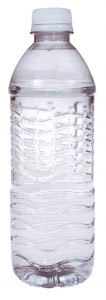 choose bottled water over other beverages, says International Bottled Water Association (IBMA). In 2006, total bottled water volume exceeded 8.25 billion gallons, a 9.5% increase over 2005; per capita consumption level of 27.6 gallons increased by over two gallons, from 2005’s 25.4 gallons. Bottled water is comprehensively regulated by the U.S. Food and Drug Administration (FDA) as a packaged food product, and has issued stringent standards for safety, quality, production, labeling, and identity. As with municipal water supplies, states also regulate bottled water inspections, sampling, analyzing and approving bottled water sources. However, all is not hunky-dory in wa-wa land. The biggest problem resulting from America’s love of bottled water is increased petroleum to make the plastic bottles, and increased landfill from the cast-offs. Last month, several restaurants in the San Francisco Bay area, including the famed Chez Panisse in Berkeley, decided to cease serving bottled water, sacrificing profits in the name of environmental protection. Nearly 1 billion bottles that will not degrade for 1,000 years, end up in landfills every year, according to a recent article in the Contra Costa Times, citing a 2003 California Department of Conservation report. The Earth Policy Institute in Washington, D.C., estimates that making plastic water bottles to quench America’s thirst burns up 1.5 million barrels of crude a year. Water in glass bottles is heavier and often imported long distances, which burns up gasoline. Photo of water bottle by Nathan Bauer | stock.xchng. choose bottled water over other beverages, says International Bottled Water Association (IBMA). In 2006, total bottled water volume exceeded 8.25 billion gallons, a 9.5% increase over 2005; per capita consumption level of 27.6 gallons increased by over two gallons, from 2005’s 25.4 gallons. Bottled water is comprehensively regulated by the U.S. Food and Drug Administration (FDA) as a packaged food product, and has issued stringent standards for safety, quality, production, labeling, and identity. As with municipal water supplies, states also regulate bottled water inspections, sampling, analyzing and approving bottled water sources. However, all is not hunky-dory in wa-wa land. The biggest problem resulting from America’s love of bottled water is increased petroleum to make the plastic bottles, and increased landfill from the cast-offs. Last month, several restaurants in the San Francisco Bay area, including the famed Chez Panisse in Berkeley, decided to cease serving bottled water, sacrificing profits in the name of environmental protection. Nearly 1 billion bottles that will not degrade for 1,000 years, end up in landfills every year, according to a recent article in the Contra Costa Times, citing a 2003 California Department of Conservation report. The Earth Policy Institute in Washington, D.C., estimates that making plastic water bottles to quench America’s thirst burns up 1.5 million barrels of crude a year. Water in glass bottles is heavier and often imported long distances, which burns up gasoline. Photo of water bottle by Nathan Bauer | stock.xchng.
Pricey Bottled Water: Beating The System. Many Americans who drink the more than $10 billion of bottled water a year often don’t care what they pay for it. Instead of tap water in restaurants, mark-up can be 400% to 600%—far higher than the 200% to 300% accepted for wine. Aquabar, an importer of unusual brands of bottled water, argues that while a premium for convenience and service is understandable, a 400% mark-up for a bottle of water that can be found at any 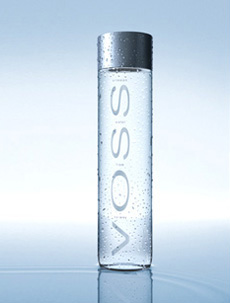 supermarket (Acqua Panna, Evian, Fiji, Pellegrino, Voss) seems a little steep. If you want to earn your mark-up, offer the consumer waters with special or unique properties that are difficult to come by at retail and enhance the dining-out experience. THE NIBBLE’s Water Editor, Michael Mascha, agrees, and consults with restaurants nationwide to pull together exciting water menus that match the cuisine and are worth paying a premium. (We review many of these exclusive bottled waters in our Bottled Waters Section.) Consumers in Aquabar’s survey also reported that they either order tap water or no water at all because they feel that they are being gouged, because in most cases, the water they were presented with did not hold a value worth paying a premium ($8 for a $1.69 bottle of Perrier, e.g.). supermarket (Acqua Panna, Evian, Fiji, Pellegrino, Voss) seems a little steep. If you want to earn your mark-up, offer the consumer waters with special or unique properties that are difficult to come by at retail and enhance the dining-out experience. THE NIBBLE’s Water Editor, Michael Mascha, agrees, and consults with restaurants nationwide to pull together exciting water menus that match the cuisine and are worth paying a premium. (We review many of these exclusive bottled waters in our Bottled Waters Section.) Consumers in Aquabar’s survey also reported that they either order tap water or no water at all because they feel that they are being gouged, because in most cases, the water they were presented with did not hold a value worth paying a premium ($8 for a $1.69 bottle of Perrier, e.g.).
Aquabar also reports how travelers are “beating the system” in a major hotel profit center, the minibar. A survey undertaken by the company revealed that savvy consumers take a quick trip to the nearest convenience store to replace the products—water, chips and candy—which saves them from paying mark-ups on in-room bottled water. Some hotels have installed sensors in an effort to curb this trend, but hotel visitors could argue that they changed their mind and returned the item. Aquabar notes that when hotels resell brands that are saturated in the market they run the risk of paying a “reverse premium” since the products are so accessible, consumers can easily replace them. Having more rare and unusual products would be a better way to go for both the company and the consumer. We agree.

4.16.07
News
Pricey Lobsters Even Pricier—If You Can Find Them. A combination of harsh winter winds that made it tough for lobstermen to get out on the water and cold water temperatures and the timing of fishing seasons has pushed retail lobster prices in Maine to about $15 a pound, probably the highest price ever. The ocean water temperature is below normal for this time of year. When the water is abnormally cold, 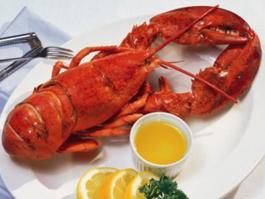 lobsters are less inclined to eat, meaning they're not likely to head into a trap in search of a meal. As a result, seafood buyers are unable to find lobsters at market, and those that are found are pricey: Steve DiMillo, owner of DiMillo’s Floating Restaurant on the Portland waterfront, he's been paying $45 a pound wholesale for lobster meat and $11.50 a pound for whole lobsters. In New York, lobsters are selling for about $18 a pound in New York, but even with the high prices, lobstermen are not catching much, so it doesn’t even pay for the fuel to head out. “Everything that can go wrong has gone wrong,” Peter McAleney, owner of New Meadows Lobster, told the Portland Herald Press / Maine Sunday Telegram. McAleney didn’t even open Sunday morning as usual, because lobster supplies are close to non-existent. Relief is in sight: The water will begin to warm and perk up lobsters’ appetites, and the Canadian lobster season will start soon. There may be supply, but will there still be sticker shock at the seafood counter? Photo courtesy Hancock Lobster. lobsters are less inclined to eat, meaning they're not likely to head into a trap in search of a meal. As a result, seafood buyers are unable to find lobsters at market, and those that are found are pricey: Steve DiMillo, owner of DiMillo’s Floating Restaurant on the Portland waterfront, he's been paying $45 a pound wholesale for lobster meat and $11.50 a pound for whole lobsters. In New York, lobsters are selling for about $18 a pound in New York, but even with the high prices, lobstermen are not catching much, so it doesn’t even pay for the fuel to head out. “Everything that can go wrong has gone wrong,” Peter McAleney, owner of New Meadows Lobster, told the Portland Herald Press / Maine Sunday Telegram. McAleney didn’t even open Sunday morning as usual, because lobster supplies are close to non-existent. Relief is in sight: The water will begin to warm and perk up lobsters’ appetites, and the Canadian lobster season will start soon. There may be supply, but will there still be sticker shock at the seafood counter? Photo courtesy Hancock Lobster.
Lasered Fruit “Stickers.” The stickers on fruits and vegetables commonly bear a standard code, called a produce look-up or PLU code, used to ring up the produce at the register. They also can include brand names, logos and country of origin information. If you’re tired of peeling them off, consider the alternative. Durand-Wayland Inc., a Georgia manufacturer of spraying, packing and labeling machinery, wants to start selling a $38,000 laser that etches indelible but edible labels onto the 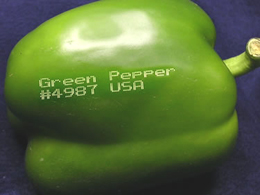 skins. The machine has been available for two years, but the FDA required proof that the process was safe (Any source of radiation, including the light of a laser, used to treat or process food is considered a food additive). The company filed its petition with test results on March 5, and the agency has 180 days to review it. If approved, label-makers won’t be happy, and some consumers won’t be either. It does mar the aesthetic of the food and if you’re planning on serving slices to guests...do you want to be serving code numbers? (Laser etching works with most fruits but not with lumpy ones like cantaloupes or light ones where there is insufficient contrast). Kathy Means, spokesperson for the Produce Marketing Association, called the technology intriguing, and that the industry is always seeking ways to make things better and easier. A test in an Oregon grower’s cooperative showed figures that the machine could pay for itself in five years, all while eliminating consumer sticker frustration and improving produce safety (if there is a problem like e.coli, the product can immediately be traced back to the grower). She said that it would go ahead if there are no safety concerns. The Association estimates 60 percent of the most commonly sold fruits and vegetables are already labeled for origin, either by country or region, typically with stickers or tags. Such labeling is voluntary now. The 2002 Farm Act made country-of-origin labeling mandatory for seafood, meat and produce, but the requirement is on hold until September 2008 for the latter two foods. skins. The machine has been available for two years, but the FDA required proof that the process was safe (Any source of radiation, including the light of a laser, used to treat or process food is considered a food additive). The company filed its petition with test results on March 5, and the agency has 180 days to review it. If approved, label-makers won’t be happy, and some consumers won’t be either. It does mar the aesthetic of the food and if you’re planning on serving slices to guests...do you want to be serving code numbers? (Laser etching works with most fruits but not with lumpy ones like cantaloupes or light ones where there is insufficient contrast). Kathy Means, spokesperson for the Produce Marketing Association, called the technology intriguing, and that the industry is always seeking ways to make things better and easier. A test in an Oregon grower’s cooperative showed figures that the machine could pay for itself in five years, all while eliminating consumer sticker frustration and improving produce safety (if there is a problem like e.coli, the product can immediately be traced back to the grower). She said that it would go ahead if there are no safety concerns. The Association estimates 60 percent of the most commonly sold fruits and vegetables are already labeled for origin, either by country or region, typically with stickers or tags. Such labeling is voluntary now. The 2002 Farm Act made country-of-origin labeling mandatory for seafood, meat and produce, but the requirement is on hold until September 2008 for the latter two foods.
Product Watch
“Wine For Dummies” No Longer Needed. Americans want to drink better and more sophisticated wines, but learning how to match wines with food becomes more of 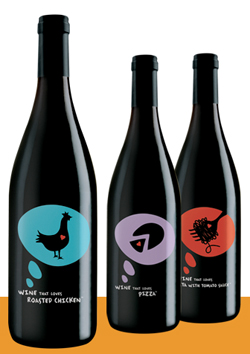 a scholarly pursuit than many have time for—especially the 20-something wine-drinkers who are driving growth in the U.S. wine industry. Wine That Loves™, from San Francisco-based Amazing Food Wine Company, has a simple-but-brilliant solution: The label shows the food that the wine loves to be paired with and the busy shopper needs to just look and grab the label with the grilled salmon, pasta with tomato sauce or whatever (the wines are designed to be paired with the most popular American dinnertime fare). The individual bottlings have names like “Wine That Loves Grilled Steak” and “Wine That Loves Roast Chicken.” While wine bottles typically have grape types and vintage years—which don’t tell buyers what they really want to know—these wines are nonvintage with a back label that explains what the wine is going to taste like and why it pairs with the food. “Wine That Loves Pizza,” for example, reads, “Pizza crust can create a dry mouth feel, so the right wine needs to be low in tannin...Because of the tomato sauce, pizza demands a wine that is red-fruit dominant.” The wines will be available online from WineThatLoves.com by the end this month, and will retail for around $12. The company will begin retailing in California by May, and is in negotiation with retailers and distributors for broader distribution. a scholarly pursuit than many have time for—especially the 20-something wine-drinkers who are driving growth in the U.S. wine industry. Wine That Loves™, from San Francisco-based Amazing Food Wine Company, has a simple-but-brilliant solution: The label shows the food that the wine loves to be paired with and the busy shopper needs to just look and grab the label with the grilled salmon, pasta with tomato sauce or whatever (the wines are designed to be paired with the most popular American dinnertime fare). The individual bottlings have names like “Wine That Loves Grilled Steak” and “Wine That Loves Roast Chicken.” While wine bottles typically have grape types and vintage years—which don’t tell buyers what they really want to know—these wines are nonvintage with a back label that explains what the wine is going to taste like and why it pairs with the food. “Wine That Loves Pizza,” for example, reads, “Pizza crust can create a dry mouth feel, so the right wine needs to be low in tannin...Because of the tomato sauce, pizza demands a wine that is red-fruit dominant.” The wines will be available online from WineThatLoves.com by the end this month, and will retail for around $12. The company will begin retailing in California by May, and is in negotiation with retailers and distributors for broader distribution.
Smart Coffee Lid. A color-changing disposable coffee lid from Smart Lid Systems, an Australian company, has won a Dupont® Packaging Award, and promises to make 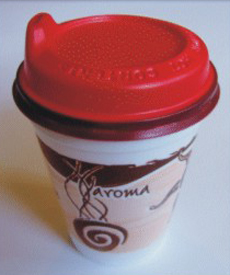 take-out coffee a more consumer-friendly experience. The lid changes color, from dark brown to bright red (warning!), when placed on a hot beverage, alerting consumers that their coffee or tea may be too hot. The color change slowly changes back to the brown as the drink cools, signaling that one’s beverage is cooling down. More importantly, it also visually indicates if it is securely attached to the take-out cup (if not, a broken color ring appears on the lid), an instant visual warning for baristas and drinkers about potential spillages. The smart lid, which costs about an extra penny apiece, was about 5 years in development. To compensate for the extra cost, logos and text can be made to appear and slowly disappear on top of the lid, creating branding and advertising opportunities. take-out coffee a more consumer-friendly experience. The lid changes color, from dark brown to bright red (warning!), when placed on a hot beverage, alerting consumers that their coffee or tea may be too hot. The color change slowly changes back to the brown as the drink cools, signaling that one’s beverage is cooling down. More importantly, it also visually indicates if it is securely attached to the take-out cup (if not, a broken color ring appears on the lid), an instant visual warning for baristas and drinkers about potential spillages. The smart lid, which costs about an extra penny apiece, was about 5 years in development. To compensate for the extra cost, logos and text can be made to appear and slowly disappear on top of the lid, creating branding and advertising opportunities.
T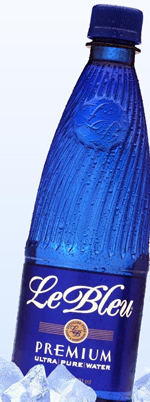 rends rends
Kosher Bottled Water. While water in theory is parve and does not need to be certified kosher, the appearance of animal microbes in New York City water led to the emergency of kosher-certified water (kosher observers cannot eat any bugs or products derived from them, such as cochineal dye). While anyone can take a tap water product and have it certified kosher (and we tasted one dreadful such product), Le Bleu Bottled Water, from a spring in North Carolina, was recently voted the “Best Non-Alcoholic Beverage in the Western Hemisphere” at the International Food and Beverage Trade Show in Miami. No matter how good the water, that must have been one thirsty judging panel! Available in 5-gallon coolers and various sizes of bottles by the case including the “premium” blue bottle for hotels and foodservice (shown in photo), 16-ounce bottles also can be private labeled for business and party favors. Learn more at http://www.lebleu.com.
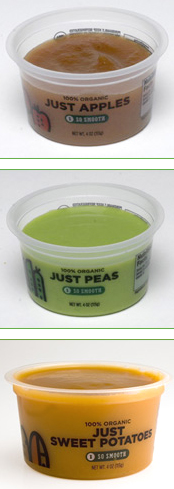 Fresh, Organic Baby Food. If you live in a large city and have a baby, you may be interested in a new, emerging food category: fresh, refrigerated baby food, certified organic. Last year saw the debut of fresh-frozen food, from Baby Cubes in San Jose, California (read our review) and Nummy Nums in Los Angeles to Happy Baby in Brooklyn, New York and Taste Bud Organic Baby Food in upstate Delancey, New York. Now, Homemade Baby in Culver City, California and Yummy Spoonfuls in Georgia are providing healthier, more nutritious foods for babies and toddlers, and has created a tasty new food category: fresh, organic “grab and go” baby food that are found in the refrigerated section of natural products stores, near the baby yogurts. Homemade Baby is also kosher and made to satisfy three stages of a baby's development: So Smooth (6-8 months), Good Mushy (9-12 months), and Kinda Chunky (12+ months). While you’ll need to wait for it to come to your local retailer, Yummy Spoonfuls and frozen Baby Cubes sell from their websites. Baby food returns to its origins: commercial baby food has only been sold in shelf-stable glass jars since 1928. Prior to then, mothers made food for babies—without the help of an electric food processor! Everything old is new again. Fresh, Organic Baby Food. If you live in a large city and have a baby, you may be interested in a new, emerging food category: fresh, refrigerated baby food, certified organic. Last year saw the debut of fresh-frozen food, from Baby Cubes in San Jose, California (read our review) and Nummy Nums in Los Angeles to Happy Baby in Brooklyn, New York and Taste Bud Organic Baby Food in upstate Delancey, New York. Now, Homemade Baby in Culver City, California and Yummy Spoonfuls in Georgia are providing healthier, more nutritious foods for babies and toddlers, and has created a tasty new food category: fresh, organic “grab and go” baby food that are found in the refrigerated section of natural products stores, near the baby yogurts. Homemade Baby is also kosher and made to satisfy three stages of a baby's development: So Smooth (6-8 months), Good Mushy (9-12 months), and Kinda Chunky (12+ months). While you’ll need to wait for it to come to your local retailer, Yummy Spoonfuls and frozen Baby Cubes sell from their websites. Baby food returns to its origins: commercial baby food has only been sold in shelf-stable glass jars since 1928. Prior to then, mothers made food for babies—without the help of an electric food processor! Everything old is new again.
Photo: Some of Homemade Baby’s fresh, organic baby foods.

4.9.07
News
Potential Bad News For Chocolate—But You Can Help. The Chocolate Manufacturers Association (CMA)—whose members include influential giants such as Archer Daniels Midland, Hershey, Nestlé—has petitioned the Food & Drug Administration (FDA) to change the legal definition of chocolate. Specifically, they want to allow the substitution of the much cheaper vegetable oil (including trans fats) for cocoa butter in chocolate, and to be able to call that product “chocolate.” Today, such products must be called “confectioner's coating”—and clearly taste inferior to real chocolate. (The reason so many people don’t like white chocolate is that for years it was not classified as “real chocolate,” so most of it was (and still is) made with vegetable oil.) The CMA also wants to be able to use “milk substitutes” instead of milk in milk chocolate—and still label this inferior product “chocolate.” Those who favor the change say that “Consumers can just read the label to see what they’re getting.” Except that in many cases, we buy prepared foods—bakery and restaurant cakes, cookies and ice cream, e.g.—where we can’t “read the label.” includes trans fats) as well as the ability to use milk substitutes in place of nutritionally-superior milk.
Approval of this petition would signify a serious degradation of our foods for the profit of a group of manufacturers. We believe it would encourage other industries to follow suit, e.g., to petition for what is now called “imitation cheese” to be called “cheese,” or for margarine to be called butter. There is no way this benefits consumers. From a health standpoint alone, substituting heart-healthy cocoa butter for partially hydrogenated, artery-cloggingtrans fats supports a known health hazard.
You have the opportunity to comment on this detrimental petition and sway the decision of the FDA against it. Guittard Chocolate has developed a website, DontMessWithOurChocolate.guittard.com, so that you can read the facts. Follow the link there called “What You Can Do” to the docket on the FDA website, where you can leave your comments—as brief or extensive as you like (Mac users, you need to use the Safari browser). |
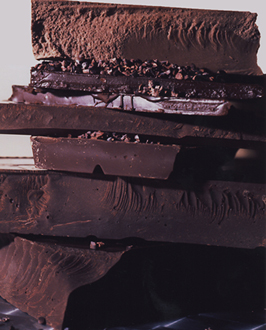
Think of what this would taste like made
with vegetable oil instead of cocoa butter! |
The FDA is supposed to protect consumers, not help manufacturers generate higher profits at the expense of delivering quality products to consumers. It’s easy not to get involved; but even if you don’t care about trans fats, the first time you bite into an inferior-tasting, oily mouthfeel piece of “chocolate,” you’ll wish you had taken 5 minutes stop the vegetable oil. You must add your comments by April 25th. Thanks for taking 5 minutes to help protect our chocolate supply.
Ironically, Butter Is A Trans Fat. Yes, it’s true. But it’s a natural trans fat, found in small amounts in butter and meat, not an artificial trans fat, the bad fat that has been causing all the hoopla and generating bans. Legislation in New York and other municipalities has targeted the type of artificial trans fat created by partial 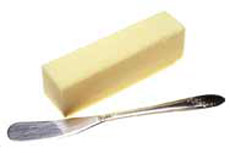 hydrogenation, which turns liquid oil into a solid fat like shortening. Trans fat is also created when certain inexpensive and sturdy oils are heated in deep-fat fryers. Artificial trans fat has been popular commercially, adding creaminess and shelf life to commercial baked goods; in products like Crisco® (which has since removed trans fats) it made a flaky pie crust. While some researchers believe the natural trans fats may actually be beneficial, to the Food and Drug Administration, which supervises most packaged food labeling, there is no difference between the two. An FDA rule that took effect last year states that if a product has a half a gram or more of trans fat per serving, the amount has to go on the food label and the food can’t be called trans fat-free, even if butter is the only fat. New York City health officials banned artificial restaurants from restaurants, after health studies showed that even a couple of grams of it a day can significantly increase the chance of a heart attack. Now, in an ironic twist, production contracts that include bans against all trans fat so they can be labeled “trans fat free” are disregarding the natural trans fat, meaning that wholesale bakers cannot use butter in their products! As reported by The New York Times, the bakers are being forced to substitute processed fats like palm oil and margarine for good old-fashioned butter because of the small amounts of natural trans fat that butter contains. The next time you see baked goods labeled, “contains no trans fats,” read the label for what they contain instead! By the way, 1/4-pound butter has 3.12g natural trans fat, 1/4-pound ground beef has 1.33g, 1/4-pound brie has 1.12g and 8 ounces of milk has .24g. hydrogenation, which turns liquid oil into a solid fat like shortening. Trans fat is also created when certain inexpensive and sturdy oils are heated in deep-fat fryers. Artificial trans fat has been popular commercially, adding creaminess and shelf life to commercial baked goods; in products like Crisco® (which has since removed trans fats) it made a flaky pie crust. While some researchers believe the natural trans fats may actually be beneficial, to the Food and Drug Administration, which supervises most packaged food labeling, there is no difference between the two. An FDA rule that took effect last year states that if a product has a half a gram or more of trans fat per serving, the amount has to go on the food label and the food can’t be called trans fat-free, even if butter is the only fat. New York City health officials banned artificial restaurants from restaurants, after health studies showed that even a couple of grams of it a day can significantly increase the chance of a heart attack. Now, in an ironic twist, production contracts that include bans against all trans fat so they can be labeled “trans fat free” are disregarding the natural trans fat, meaning that wholesale bakers cannot use butter in their products! As reported by The New York Times, the bakers are being forced to substitute processed fats like palm oil and margarine for good old-fashioned butter because of the small amounts of natural trans fat that butter contains. The next time you see baked goods labeled, “contains no trans fats,” read the label for what they contain instead! By the way, 1/4-pound butter has 3.12g natural trans fat, 1/4-pound ground beef has 1.33g, 1/4-pound brie has 1.12g and 8 ounces of milk has .24g.
Product Watch
New Teas At Numi. Numi, whose teas are organic, kosher, halal, and Fair Trade Certified™,* has introduced 5 new teas, spanning white, green and black. There are two organic, Fair Trade Certified Bai Mu Dan white teas from China’s Jiangxi Province Velvet Garden (mixed with pink rose buds) and White Nectar (mixed with osmanthus flowers, which impart an apricot-like flavor). White tea has higher antioxidant levels than green or black teas, and very subtle flavors due to the halting of the oxidation process immediately after picking. New green teas include Gen Mai Cha, green tea with toasted rice; and Ginger Sun, a decaffeinated, Fair Trade Certified tea with ginger and lemongrass. For black tea-lovers, Indian Night is a decaffeinated, Fair Trade Certified black tea flavored with vanilla bean. In addition to offering a soothing cup of tea, Numi makes cocktails with its teas, too. Take a look at the recipes for a tea martini and other tea-based cocktails.
*Many, but not all, Numi selections are Fair Trade Certified.
Trends
Wine Sales Seeing Red. Sales growth of red wine outpaced sales growth of the 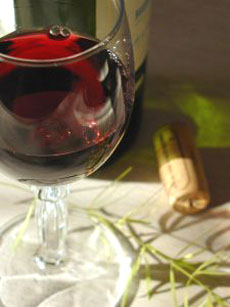 total category by 40% in the 20 weeks from November through March 10, according to figures just released by The Nielsen Company. Red wine dollar sales are up 8.5% versus 6.0% for total wine sales. This reflects increased attention to the potential health benefits of red wine after the Harvard Medical School and the National Institute on Aging released favorable reports on the benefits of red wine in early November. The medical studies found that daily doses of resveratrol, a substance in red wine, may slow the aging process. Prior to the study, white wine sales growth of outpaced red wine growth, 9.3% to 8.4%. The top two red wine varietals, Cabernet Sauvignon and Merlot, experienced volume growth of 12.9% and 5.3% respectively, while the 24.0% volume growth of Pinot Noir's is still enjoying a halo effect from the 2004 film, “Sideways” (which is probably putting a bit of a damper on the sales of Merlot). total category by 40% in the 20 weeks from November through March 10, according to figures just released by The Nielsen Company. Red wine dollar sales are up 8.5% versus 6.0% for total wine sales. This reflects increased attention to the potential health benefits of red wine after the Harvard Medical School and the National Institute on Aging released favorable reports on the benefits of red wine in early November. The medical studies found that daily doses of resveratrol, a substance in red wine, may slow the aging process. Prior to the study, white wine sales growth of outpaced red wine growth, 9.3% to 8.4%. The top two red wine varietals, Cabernet Sauvignon and Merlot, experienced volume growth of 12.9% and 5.3% respectively, while the 24.0% volume growth of Pinot Noir's is still enjoying a halo effect from the 2004 film, “Sideways” (which is probably putting a bit of a damper on the sales of Merlot).
Halal Certification Goes Global. Expect to see more halal certification symbols on the products you purchase. The islam practice of halal refers to foods that are free of  alcohol (e.g., chocolates can have no trace of alcohol), pork or any product from an animal not slaughtered according to Islamic guidelines (Islamic guidelines regarding meat are similar to kosher guidelines). “Halal” means lawful or permissible. With 1.6 billion Muslims worldwide and Islam the fastest-growing religion (in the U.S. as well as worldwide), halal food sales are now estimated at $500 billion annually. In 1990, only 23 companies in the world were paying for halal certification services; last year, halal products were certified for 2,000 companies. Just as rabbis certify foods to be kosher, halal foods are under the supervision of an imam, the officiating priest of a mosque. However, as with kosher foods, the certifying clergy tend not to be leaders of congregations but employees of separate certifying organizations that exist for the specific purpose of supervising food manufacturers. Each organization has its own seal of approval; an example is shown in the image above. alcohol (e.g., chocolates can have no trace of alcohol), pork or any product from an animal not slaughtered according to Islamic guidelines (Islamic guidelines regarding meat are similar to kosher guidelines). “Halal” means lawful or permissible. With 1.6 billion Muslims worldwide and Islam the fastest-growing religion (in the U.S. as well as worldwide), halal food sales are now estimated at $500 billion annually. In 1990, only 23 companies in the world were paying for halal certification services; last year, halal products were certified for 2,000 companies. Just as rabbis certify foods to be kosher, halal foods are under the supervision of an imam, the officiating priest of a mosque. However, as with kosher foods, the certifying clergy tend not to be leaders of congregations but employees of separate certifying organizations that exist for the specific purpose of supervising food manufacturers. Each organization has its own seal of approval; an example is shown in the image above.

4.2.07
News
U.S. Cheese Champions. The United States Championship Cheese Contest concluded recently in Madison, Wisconsin, with top honors going to a New York State 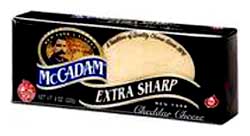 cheese, McCadam’s Extra Sharp Aged Cheddar. The competition, sponsored by the nonprofit Wisconsin Cheese Makers Association, has been held during odd-numbered years since 1981. This year a record 1,158 cheese and butter entries from 26 states were judged during the three-day event by a panel of 17 expert judges. Gold, silver and bronze medalists were selected in 53 classes, with cheeses and butters divided into classes like Cheddar, Gorgonzola, Hard Goat’s Milk Cheeses, Soft and Semisoft Sheep’s Milk Cheeses and Unsalted Butter. A raw milk, Alpine-style cheese “Roth’s Private Reserve,” made by Roth Käse USA Ltd. of Monroe, Wisconsin, finished as first runner-up to the U.S. Champion. In the Championship Round, scores of the top three were as close as in the Olympics®. The Second Runner-Up, a Mascarpone made by Sorrento Lactalis of Nampa, Idaho, lost out to the First Runner-Up by nine-hundredths of a point (.009). The American Cheese Society competition, an annual event, is held each July—so expect a different set of champions to be crowned soon. cheese, McCadam’s Extra Sharp Aged Cheddar. The competition, sponsored by the nonprofit Wisconsin Cheese Makers Association, has been held during odd-numbered years since 1981. This year a record 1,158 cheese and butter entries from 26 states were judged during the three-day event by a panel of 17 expert judges. Gold, silver and bronze medalists were selected in 53 classes, with cheeses and butters divided into classes like Cheddar, Gorgonzola, Hard Goat’s Milk Cheeses, Soft and Semisoft Sheep’s Milk Cheeses and Unsalted Butter. A raw milk, Alpine-style cheese “Roth’s Private Reserve,” made by Roth Käse USA Ltd. of Monroe, Wisconsin, finished as first runner-up to the U.S. Champion. In the Championship Round, scores of the top three were as close as in the Olympics®. The Second Runner-Up, a Mascarpone made by Sorrento Lactalis of Nampa, Idaho, lost out to the First Runner-Up by nine-hundredths of a point (.009). The American Cheese Society competition, an annual event, is held each July—so expect a different set of champions to be crowned soon.
Champion Spirits. Want something good to go with that cheese? It’s a long trip from Wisconsin to the Mandarin Oriental Hotel in San Francisco, but there, a different set of experts at the San Francisco World Spirits Competition judged more than 700 spirits from 52 countries and 6 continents. The 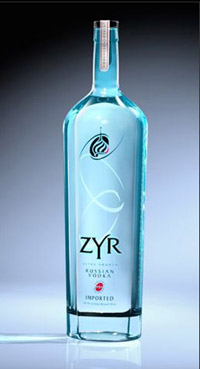 category winners follow, so you can pick up something special for Easter, Mother’s Day, Father’s Day or your own personal stock. Prices are supplied as well as the importers to help track down some of the more obscure bottlings. Aquavit: Linie Lysholm Aquavit, Norway (43%, $25, Capstone Int’l, St. Petersburg, FL); Blended Scotch: Johnnie Walker Green Label Scotch, Scotland (43%, $50, Diageo North America, Norwalk, CT); Brandy: Hennessy Richard Hennessy Cognac, Cognac, France (40%, $1800, Moet Hennessy USA, New York, NY); Cachaça: Sagatiba Velha Luxuosa Cachaça, Brazil (40%, www.sagatiba.com); Calvados: Grand Pommier XS Calvados, Normandy, France (40%, $300, Scott Levy Selections, Norcross, GA); Fruit Liqueur: Grand Marnier CuvÇe Speciale Cent Cinquantenaire, France (40%, $215, Moet Hennessy USA, New York, NY); Irish Whiskey: Jameson 12 Year Old Irish Whiskey, Ireland (40%, $39, Pernod Ricard, White Plains, NY); Liqueur: Chartreuse Green, Herbal Liqueur, Voiron, France (55%, $48, Frederick Wildman, New York, NY); North American Whiskey: Rittenhouse Bottled-in-Bond Rye Whiskey (50%, Kentucky, $13, www.heaven-hill.com); Rum: Ron Matusalem 10 Year Old Clasico Rum, Dominican Republic (40%, $20, Skyy Spirits, San Francisco, CA); Tequila: El Tesoro El Tesoro Paradiso, Jalisco, Mexico (40%, $121, Beam Global, Deerfield, IL); Vodka: Zyr Vodka, Moscow, Russia (40%, $32, Symphony Importers, New York, NY); White: Plymouth Gin, Devon, England (41.2%, $23, Absolut Spirits Co., New York, NY); Whiskey: Laphroaig 30 Year Old Single Malt Scotch, Islay, Scotland (43%, $240, Beam Global, Deerfield, IL). Photo: The Best Of Show Vodka: Zyr Russian Vodka. category winners follow, so you can pick up something special for Easter, Mother’s Day, Father’s Day or your own personal stock. Prices are supplied as well as the importers to help track down some of the more obscure bottlings. Aquavit: Linie Lysholm Aquavit, Norway (43%, $25, Capstone Int’l, St. Petersburg, FL); Blended Scotch: Johnnie Walker Green Label Scotch, Scotland (43%, $50, Diageo North America, Norwalk, CT); Brandy: Hennessy Richard Hennessy Cognac, Cognac, France (40%, $1800, Moet Hennessy USA, New York, NY); Cachaça: Sagatiba Velha Luxuosa Cachaça, Brazil (40%, www.sagatiba.com); Calvados: Grand Pommier XS Calvados, Normandy, France (40%, $300, Scott Levy Selections, Norcross, GA); Fruit Liqueur: Grand Marnier CuvÇe Speciale Cent Cinquantenaire, France (40%, $215, Moet Hennessy USA, New York, NY); Irish Whiskey: Jameson 12 Year Old Irish Whiskey, Ireland (40%, $39, Pernod Ricard, White Plains, NY); Liqueur: Chartreuse Green, Herbal Liqueur, Voiron, France (55%, $48, Frederick Wildman, New York, NY); North American Whiskey: Rittenhouse Bottled-in-Bond Rye Whiskey (50%, Kentucky, $13, www.heaven-hill.com); Rum: Ron Matusalem 10 Year Old Clasico Rum, Dominican Republic (40%, $20, Skyy Spirits, San Francisco, CA); Tequila: El Tesoro El Tesoro Paradiso, Jalisco, Mexico (40%, $121, Beam Global, Deerfield, IL); Vodka: Zyr Vodka, Moscow, Russia (40%, $32, Symphony Importers, New York, NY); White: Plymouth Gin, Devon, England (41.2%, $23, Absolut Spirits Co., New York, NY); Whiskey: Laphroaig 30 Year Old Single Malt Scotch, Islay, Scotland (43%, $240, Beam Global, Deerfield, IL). Photo: The Best Of Show Vodka: Zyr Russian Vodka.
Asparagus: A Delicate Matter. In our global village, a large amount of produce comes from foreign shores. Much of the world’s asparagus crop is now grown in South  America (California and Mexico also supply a large amount of our asparagus). Large asparagus growers in Washington State, a former asparagus-growing stronghold, have been moving their operations to South America where, among other things, the seasonal labor force is more reliable. In Washington State, asparagus farmers often unsuccessfully compete with cherry growers for the labor pool. But one optimistic Washington farmer, Steve Lynch, is planting 340 acres of the green delicacy: His crew of 50 workers is diligently planting 20,000 asparagus crowns per acre. When the weather is warm, a spear can grow about 4 to 6 inches in a day from the crown. That doesn’t mean there will be asparagus next week: The newly planted asparagus won’t be ready for harvest until 2009. But the plants last about 13 to 15 years before they stop producing. Asparagus season begins in mid-April and generally lasts through mid-June. The next time you enjoy a dish of asparagus, you’ll appreciate the journey as well as the flavor. America (California and Mexico also supply a large amount of our asparagus). Large asparagus growers in Washington State, a former asparagus-growing stronghold, have been moving their operations to South America where, among other things, the seasonal labor force is more reliable. In Washington State, asparagus farmers often unsuccessfully compete with cherry growers for the labor pool. But one optimistic Washington farmer, Steve Lynch, is planting 340 acres of the green delicacy: His crew of 50 workers is diligently planting 20,000 asparagus crowns per acre. When the weather is warm, a spear can grow about 4 to 6 inches in a day from the crown. That doesn’t mean there will be asparagus next week: The newly planted asparagus won’t be ready for harvest until 2009. But the plants last about 13 to 15 years before they stop producing. Asparagus season begins in mid-April and generally lasts through mid-June. The next time you enjoy a dish of asparagus, you’ll appreciate the journey as well as the flavor.
Product Watch
Peeled Snacks’ New Snack. Plu-what?, a new blend of fruits and nuts, has joined 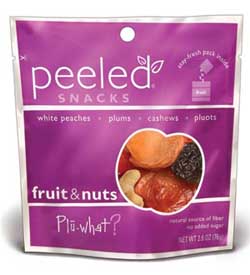 the Peeled Snacks family of healthy snacks. The mix of pluots (a hybrid of plums and apricots), white peaches, plums and cashews hits the spot with its soft, sweet flavors: the most “feminine” of the Peeled Snacks flavors, we think, in that there’s no bite from walnuts or sharpness fruit flavors. It just might be our second favorite flavor. The purple color looks great in an Easter basket, and is a better-for-you alternative for people seeking to resist the call of the chocolate bunny. You can order Peeled Snacks online, a case of 12 individual packages for $24.99. Read our full review of Peeled Snacks and you may become converts to this Top Pick Of The Week. the Peeled Snacks family of healthy snacks. The mix of pluots (a hybrid of plums and apricots), white peaches, plums and cashews hits the spot with its soft, sweet flavors: the most “feminine” of the Peeled Snacks flavors, we think, in that there’s no bite from walnuts or sharpness fruit flavors. It just might be our second favorite flavor. The purple color looks great in an Easter basket, and is a better-for-you alternative for people seeking to resist the call of the chocolate bunny. You can order Peeled Snacks online, a case of 12 individual packages for $24.99. Read our full review of Peeled Snacks and you may become converts to this Top Pick Of The Week.
Trends
More Organics For Fido & Fluffy. The already fast-growing organic pet food category has been spurred to even greater growth by the tragedy of tainted pet foods 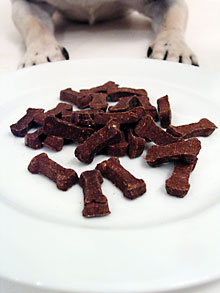 which recently killed at least 16 pets (reports indicate higher numbers, but the maker of the recalled pet food has confirmed 16 to date). Despite a huge price differential—a 5-pound bag of commercial kibble can be had for $2.00, compared to $15.00 for an organic brand—many furry family members will be eating better. According to the most recent data from the Organic Trade Association, sales of organic pet food more than doubled from $14 million in 2003 to $30 million in 2005—still just a fraction of the $14.3 billion in 2005 sales of commercial pet food reported by the Pet Food Institute. In addition to organic foods, there are popular brands such as Wellness that are not certified organic but are made of human-quality, natural ingredients. A committee of the USDA’s National Organic Standards Board is reviewing standards for labeling of organic pet foods that could go into effect by 2008. Photo: Organic Dog Treat from PamperedPuppy.com. which recently killed at least 16 pets (reports indicate higher numbers, but the maker of the recalled pet food has confirmed 16 to date). Despite a huge price differential—a 5-pound bag of commercial kibble can be had for $2.00, compared to $15.00 for an organic brand—many furry family members will be eating better. According to the most recent data from the Organic Trade Association, sales of organic pet food more than doubled from $14 million in 2003 to $30 million in 2005—still just a fraction of the $14.3 billion in 2005 sales of commercial pet food reported by the Pet Food Institute. In addition to organic foods, there are popular brands such as Wellness that are not certified organic but are made of human-quality, natural ingredients. A committee of the USDA’s National Organic Standards Board is reviewing standards for labeling of organic pet foods that could go into effect by 2008. Photo: Organic Dog Treat from PamperedPuppy.com.
Your Supermarket: It’s A Small World After All. If you’re a GenXer or older American of European descent, your grandmother probably never made guacamole or 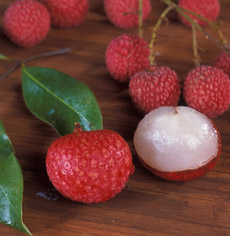 threw bok choy into a stir-fry, and you may have been the first in your family to slice a kiwi. But that’s all old hat now: Kindergartners to seniors are drinking pomegranate juice and eating chipotle potato chips as if they’ve always been part of the cuisine. Americans want more of the foods and ingredients they’ve eaten on their travels abroad; the great melting pot brings immigrants from every corner of the world, with their ingredients and recipes. As a result, nearly 90% of supermarkets carry ethnic foods, according to the Food Marketing Institute, and the trend is growing. The Center for Culinary Development, a marketing company that develops food and beverage products based on marketplace trends, lists guajillo and habañero chiles, guaraná, guava, lychee and tamarind as up-and-coming flavors. Those always browsing for exciting new recipes should have a lot to look forward to. Photo: Fresh lychee photographed by Peggy Greb, U.S. Agricultural Research Service. threw bok choy into a stir-fry, and you may have been the first in your family to slice a kiwi. But that’s all old hat now: Kindergartners to seniors are drinking pomegranate juice and eating chipotle potato chips as if they’ve always been part of the cuisine. Americans want more of the foods and ingredients they’ve eaten on their travels abroad; the great melting pot brings immigrants from every corner of the world, with their ingredients and recipes. As a result, nearly 90% of supermarkets carry ethnic foods, according to the Food Marketing Institute, and the trend is growing. The Center for Culinary Development, a marketing company that develops food and beverage products based on marketplace trends, lists guajillo and habañero chiles, guaraná, guava, lychee and tamarind as up-and-coming flavors. Those always browsing for exciting new recipes should have a lot to look forward to. Photo: Fresh lychee photographed by Peggy Greb, U.S. Agricultural Research Service.
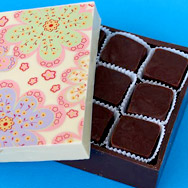 Offers Offers
Charles Chocolate Easter Goodies. Send Easter treats or anything else from Charles Chocolates by April 30, 2007, and enjoy a 15% discount (it pays for the shipping and more). How about a box of Fleur de Sel Caramels or Orange and Lemon Marzipan in an edible chocolate box—the bottom is dark chocolate and the top is white chocolate! Enter promotion code SPRING2007 through April 30, 2007.
Save Our Planet & Win A Prize. Uncommon Goods, an e-tailer of uncommonly nice items for home, personal use and gifts, is celebrating Earth Day, April 22, with a challenge to consumers: What can we do to make the world a better place? If you have a suggestion for society as a whole, or for Uncommon Goods as a company, send it in 500 words or less by April 18. The top 3 ideas will win Uncommon Goods gift certificates, and runners up will win Environmental Karma Cards. For more information, visit the Uncommonly Green Contest at UncommonGoods.com.

News Archives
| 1st Quarter 2007 |
4th Quarter 2006 |
3rd Quarter 2006 |
|
|
|
| 2nd Quarter 2006 |
1st Quarter 2006 |
4th Quarter 2005 |
|
|
|
| 3rd Quarter 2005 |
2nd Quarter 2005 |
1st Quarter 2005 |
|
|
|
Send your product news to:
Info at TheNibble. com.
Substitute @ for <at> and use TheNibble.com with no space. We use this convention to avoid address-harvesting spam spiders.
Don’t Miss The News:
Subscribe To Our Gourmet News & Views News Feed
Lifestyle Direct Direct, Inc. All rights reserved. Images are the copyright of their respective owners.

|




 Peep at these candy chicks from WilliamsSonoma.com. Read our recommendations of more
Peep at these candy chicks from WilliamsSonoma.com. Read our recommendations of more 

 enjoyed by consumers and served at hotels and restaurants around the country for years, has opened its first U.S. café, in the District of Columbia. Named simply Caffè, the Italian spelling for coffee and café, the shop opened last week in Marriott’s Renaissance M Street Hotel. It features sleek red-and-white decor and the chain’s signature ceramic espresso cup. There are no tables, only a stand-up bar on which patrons can rest an elbow, European-style. Starbuck’s may not be quaking yet, but in terms of the taste of the coffee and espresso, the ambience, and the option, we look forward to more red and white Caffès mushrooming around the country.
enjoyed by consumers and served at hotels and restaurants around the country for years, has opened its first U.S. café, in the District of Columbia. Named simply Caffè, the Italian spelling for coffee and café, the shop opened last week in Marriott’s Renaissance M Street Hotel. It features sleek red-and-white decor and the chain’s signature ceramic espresso cup. There are no tables, only a stand-up bar on which patrons can rest an elbow, European-style. Starbuck’s may not be quaking yet, but in terms of the taste of the coffee and espresso, the ambience, and the option, we look forward to more red and white Caffès mushrooming around the country.  which participants chose their tap water over Fiji. (In fact, despite the $11 billion spent annually on bottled water, tap water wins most of the time in taste tests nationwide.) Study after study has concluded that bottled water is neither cleaner nor greener than tap water. “The Natural Resources Defense Council discovered that a surprising number of the bottled waters they tested contained contaminants, pesticide residues and heavy metals,” the authors write. They point out that the Environmental Protection Agency imposes and enforces rigid standards for municipal tap water, while the Food and Drug Administration, which oversees bottled water, pays more attention to what’s on the labels of the bottles than what’s in the water inside. However, the real issue raised by the activists and the authors is bigger than just bottled water versus tap water. The book addresses recent water fights in Wisconsin and Michigan to prevent Switzerland-based Nestlé Corp., the owner of Perrier, San Pellegrino, Aqua Panna, Vittel, Contrex and several other bottled-water companies, from opening plants in their areas to siphon out millions of gallons of water and transport it out of the locale for sale elsewhere. “Water that is used in cities and in agriculture inside the watershed flows back into the water table. Once diverted outside the watershed, it does not return to the aquifers, streams and rivers that replenish the lakes,” the authors write. They are challenging the notion that a common resource as vital as water should be allowed to come under the control of giant multinational corporations driven solely by profit. They see the possibility of water becoming the oil of the 21st century in terms of pricing and availability if control, of it is ceded to big companies.
which participants chose their tap water over Fiji. (In fact, despite the $11 billion spent annually on bottled water, tap water wins most of the time in taste tests nationwide.) Study after study has concluded that bottled water is neither cleaner nor greener than tap water. “The Natural Resources Defense Council discovered that a surprising number of the bottled waters they tested contained contaminants, pesticide residues and heavy metals,” the authors write. They point out that the Environmental Protection Agency imposes and enforces rigid standards for municipal tap water, while the Food and Drug Administration, which oversees bottled water, pays more attention to what’s on the labels of the bottles than what’s in the water inside. However, the real issue raised by the activists and the authors is bigger than just bottled water versus tap water. The book addresses recent water fights in Wisconsin and Michigan to prevent Switzerland-based Nestlé Corp., the owner of Perrier, San Pellegrino, Aqua Panna, Vittel, Contrex and several other bottled-water companies, from opening plants in their areas to siphon out millions of gallons of water and transport it out of the locale for sale elsewhere. “Water that is used in cities and in agriculture inside the watershed flows back into the water table. Once diverted outside the watershed, it does not return to the aquifers, streams and rivers that replenish the lakes,” the authors write. They are challenging the notion that a common resource as vital as water should be allowed to come under the control of giant multinational corporations driven solely by profit. They see the possibility of water becoming the oil of the 21st century in terms of pricing and availability if control, of it is ceded to big companies.
 trends. Consumers are increasingly interested in flatbreads, similar to a pocketless pita and typically made from flattened dough. Flatbreads are the oldest breads on earth—they preceed leavening agents, which enable bread to rise. Today, there are unleavened flatbreads (crepes, tortillas, arepas, pita) as well as chewy leavened varieties (baladi, bruschetta, ciabatta, dosai, focaccia, inerja, mafrood, naan, pane carasau, piadine, pizza, tanoor)—there are about 60 different flatbreads made worldwide. So while it’s not exactly a global trend, domesticaly, new products with the name “flatbread” more than tripled to 66 last year from 20 in 2005, the most recent data available, according to research firm Mintel. A product that used to be found in specialty food and ethnic markets and restaurants has gone mainstream. Quiznos is including flatbread with much of its salad line to flatbread. Dunkin’ Donuts is testing flatbread sandwiches. Arby’s is promoting flatbread melts. And Stouffer’s, the maker of upscale frozen and microwavable foods, is rolling out a line of fancy-sounding flatbread pizzas. Flatbread often carries an upscale price. Stouffer’s flatbread at $3.99 ranks among its most expensive meals.
trends. Consumers are increasingly interested in flatbreads, similar to a pocketless pita and typically made from flattened dough. Flatbreads are the oldest breads on earth—they preceed leavening agents, which enable bread to rise. Today, there are unleavened flatbreads (crepes, tortillas, arepas, pita) as well as chewy leavened varieties (baladi, bruschetta, ciabatta, dosai, focaccia, inerja, mafrood, naan, pane carasau, piadine, pizza, tanoor)—there are about 60 different flatbreads made worldwide. So while it’s not exactly a global trend, domesticaly, new products with the name “flatbread” more than tripled to 66 last year from 20 in 2005, the most recent data available, according to research firm Mintel. A product that used to be found in specialty food and ethnic markets and restaurants has gone mainstream. Quiznos is including flatbread with much of its salad line to flatbread. Dunkin’ Donuts is testing flatbread sandwiches. Arby’s is promoting flatbread melts. And Stouffer’s, the maker of upscale frozen and microwavable foods, is rolling out a line of fancy-sounding flatbread pizzas. Flatbread often carries an upscale price. Stouffer’s flatbread at $3.99 ranks among its most expensive meals. 

 vanilla ice creams from
vanilla ice creams from  a cheesemaker in Normandy, France. His first variety, Boursin Garlic & Fine Herbs, was inspired by a traditional dish, fromage frais (fresh cheese, from cow’s milk), served with a bowl of fine herbs, which allowed each person to create his or her own personally seasoned cheese. Boursin Garlic & Fine Herbs was the first flavored fresh cheese to be sold throughout France, and was soon followed by Boursin Pepper. There’s also a Boursin Light Garlic & Fine Herbs. The brand has been owned by Unilever since 1989, and is sold in 35 countries on five continents.
a cheesemaker in Normandy, France. His first variety, Boursin Garlic & Fine Herbs, was inspired by a traditional dish, fromage frais (fresh cheese, from cow’s milk), served with a bowl of fine herbs, which allowed each person to create his or her own personally seasoned cheese. Boursin Garlic & Fine Herbs was the first flavored fresh cheese to be sold throughout France, and was soon followed by Boursin Pepper. There’s also a Boursin Light Garlic & Fine Herbs. The brand has been owned by Unilever since 1989, and is sold in 35 countries on five continents.  engendering the return of
engendering the return of  first taste was a mouthful of sugar! Yes, folks, there’s sugar in the can of tuna—in all three flavors, in fact, although the lemon juice and pepper in the Lemon & Cracked Pepper flavor cover it up. The Sundried Tomato & Basil tastes like Tuna and Candied Tomatoes—dreadful. Recently, a trade columnist opined, with respect to the national obesity and diabetes problems, that sugar was not the enemy—the problem lay with Americans who choose to eat too much sugar in their diets. We responded that he neglected to name food manufacturers who insist on adding sugar to products where they don’t belong—in bread, salad dressing, soup, pasta sauce, etc. You have to carefully read supermarket labels to find a savory product that doesn’t have sugar in it. And now tuna? Why, Bumble Bee, why?
first taste was a mouthful of sugar! Yes, folks, there’s sugar in the can of tuna—in all three flavors, in fact, although the lemon juice and pepper in the Lemon & Cracked Pepper flavor cover it up. The Sundried Tomato & Basil tastes like Tuna and Candied Tomatoes—dreadful. Recently, a trade columnist opined, with respect to the national obesity and diabetes problems, that sugar was not the enemy—the problem lay with Americans who choose to eat too much sugar in their diets. We responded that he neglected to name food manufacturers who insist on adding sugar to products where they don’t belong—in bread, salad dressing, soup, pasta sauce, etc. You have to carefully read supermarket labels to find a savory product that doesn’t have sugar in it. And now tuna? Why, Bumble Bee, why? choose bottled water over other beverages, says International Bottled Water Association (IBMA). In 2006, total bottled water volume exceeded 8.25 billion gallons, a 9.5% increase over 2005; per capita consumption level of 27.6 gallons increased by over two gallons, from 2005’s 25.4 gallons. Bottled water is comprehensively regulated by the U.S. Food and Drug Administration (FDA) as a packaged food product, and has issued stringent standards for safety, quality, production, labeling, and identity. As with municipal water supplies, states also regulate bottled water inspections, sampling, analyzing and approving bottled water sources. However, all is not hunky-dory in wa-wa land. The biggest problem resulting from America’s love of bottled water is increased petroleum to make the plastic bottles, and increased landfill from the cast-offs. Last month, several restaurants in the San Francisco Bay area, including the famed Chez Panisse in Berkeley, decided to cease serving bottled water, sacrificing profits in the name of environmental protection. Nearly 1 billion bottles that will not degrade for 1,000 years, end up in landfills every year, according to a recent article in the Contra Costa Times, citing a 2003 California Department of Conservation report. The Earth Policy Institute in Washington, D.C., estimates that making plastic water bottles to quench America’s thirst burns up 1.5 million barrels of crude a year. Water in glass bottles is heavier and often imported long distances, which burns up gasoline.
choose bottled water over other beverages, says International Bottled Water Association (IBMA). In 2006, total bottled water volume exceeded 8.25 billion gallons, a 9.5% increase over 2005; per capita consumption level of 27.6 gallons increased by over two gallons, from 2005’s 25.4 gallons. Bottled water is comprehensively regulated by the U.S. Food and Drug Administration (FDA) as a packaged food product, and has issued stringent standards for safety, quality, production, labeling, and identity. As with municipal water supplies, states also regulate bottled water inspections, sampling, analyzing and approving bottled water sources. However, all is not hunky-dory in wa-wa land. The biggest problem resulting from America’s love of bottled water is increased petroleum to make the plastic bottles, and increased landfill from the cast-offs. Last month, several restaurants in the San Francisco Bay area, including the famed Chez Panisse in Berkeley, decided to cease serving bottled water, sacrificing profits in the name of environmental protection. Nearly 1 billion bottles that will not degrade for 1,000 years, end up in landfills every year, according to a recent article in the Contra Costa Times, citing a 2003 California Department of Conservation report. The Earth Policy Institute in Washington, D.C., estimates that making plastic water bottles to quench America’s thirst burns up 1.5 million barrels of crude a year. Water in glass bottles is heavier and often imported long distances, which burns up gasoline.  supermarket (Acqua Panna, Evian, Fiji, Pellegrino, Voss) seems a little steep. If you want to earn your mark-up, offer the consumer waters with special or unique properties that are difficult to come by at retail and enhance the dining-out experience. THE NIBBLE’s Water Editor, Michael Mascha, agrees, and consults with restaurants nationwide to pull together exciting water menus that match the cuisine and are worth paying a premium. (We review many of these exclusive bottled waters in our Bottled Waters Section.) Consumers in Aquabar’s survey also reported that they either order tap water or no water at all because they feel that they are being gouged, because in most cases, the water they were presented with did not hold a value worth paying a premium ($8 for a $1.69 bottle of Perrier, e.g.).
supermarket (Acqua Panna, Evian, Fiji, Pellegrino, Voss) seems a little steep. If you want to earn your mark-up, offer the consumer waters with special or unique properties that are difficult to come by at retail and enhance the dining-out experience. THE NIBBLE’s Water Editor, Michael Mascha, agrees, and consults with restaurants nationwide to pull together exciting water menus that match the cuisine and are worth paying a premium. (We review many of these exclusive bottled waters in our Bottled Waters Section.) Consumers in Aquabar’s survey also reported that they either order tap water or no water at all because they feel that they are being gouged, because in most cases, the water they were presented with did not hold a value worth paying a premium ($8 for a $1.69 bottle of Perrier, e.g.). 
 lobsters are less inclined to eat, meaning they're not likely to head into a trap in search of a meal. As a result, seafood buyers are unable to find lobsters at market, and those that are found are pricey: Steve DiMillo, owner of DiMillo’s Floating Restaurant on the Portland waterfront, he's been paying $45 a pound wholesale for lobster meat and $11.50 a pound for whole lobsters. In New York, lobsters are selling for about $18 a pound in New York, but even with the high prices, lobstermen are not catching much, so it doesn’t even pay for the fuel to head out. “Everything that can go wrong has gone wrong,” Peter McAleney, owner of New Meadows Lobster, told the Portland Herald Press / Maine Sunday Telegram. McAleney didn’t even open Sunday morning as usual, because lobster supplies are close to non-existent. Relief is in sight: The water will begin to warm and perk up lobsters’ appetites, and the Canadian lobster season will start soon. There may be supply, but will there still be sticker shock at the seafood counter?
lobsters are less inclined to eat, meaning they're not likely to head into a trap in search of a meal. As a result, seafood buyers are unable to find lobsters at market, and those that are found are pricey: Steve DiMillo, owner of DiMillo’s Floating Restaurant on the Portland waterfront, he's been paying $45 a pound wholesale for lobster meat and $11.50 a pound for whole lobsters. In New York, lobsters are selling for about $18 a pound in New York, but even with the high prices, lobstermen are not catching much, so it doesn’t even pay for the fuel to head out. “Everything that can go wrong has gone wrong,” Peter McAleney, owner of New Meadows Lobster, told the Portland Herald Press / Maine Sunday Telegram. McAleney didn’t even open Sunday morning as usual, because lobster supplies are close to non-existent. Relief is in sight: The water will begin to warm and perk up lobsters’ appetites, and the Canadian lobster season will start soon. There may be supply, but will there still be sticker shock at the seafood counter?  skins. The machine has been available for two years, but the FDA required proof that the process was safe (Any source of radiation, including the light of a laser, used to treat or process food is considered a food additive). The company filed its petition with test results on March 5, and the agency has 180 days to review it. If approved, label-makers won’t be happy, and some consumers won’t be either. It does mar the aesthetic of the food and if you’re planning on serving slices to guests...do you want to be serving code numbers? (Laser etching works with most fruits but not with lumpy ones like cantaloupes or light ones where there is insufficient contrast). Kathy Means, spokesperson for the Produce Marketing Association, called the technology intriguing, and that the industry is always seeking ways to make things better and easier. A test in an Oregon grower’s cooperative showed figures that the machine could pay for itself in five years, all while eliminating consumer sticker frustration and improving produce safety (if there is a problem like e.coli, the product can immediately be traced back to the grower). She said that it would go ahead if there are no safety concerns. The Association estimates 60 percent of the most commonly sold fruits and vegetables are already labeled for origin, either by country or region, typically with stickers or tags. Such labeling is voluntary now. The 2002 Farm Act made country-of-origin labeling mandatory for seafood, meat and produce, but the requirement is on hold until September 2008 for the latter two foods.
skins. The machine has been available for two years, but the FDA required proof that the process was safe (Any source of radiation, including the light of a laser, used to treat or process food is considered a food additive). The company filed its petition with test results on March 5, and the agency has 180 days to review it. If approved, label-makers won’t be happy, and some consumers won’t be either. It does mar the aesthetic of the food and if you’re planning on serving slices to guests...do you want to be serving code numbers? (Laser etching works with most fruits but not with lumpy ones like cantaloupes or light ones where there is insufficient contrast). Kathy Means, spokesperson for the Produce Marketing Association, called the technology intriguing, and that the industry is always seeking ways to make things better and easier. A test in an Oregon grower’s cooperative showed figures that the machine could pay for itself in five years, all while eliminating consumer sticker frustration and improving produce safety (if there is a problem like e.coli, the product can immediately be traced back to the grower). She said that it would go ahead if there are no safety concerns. The Association estimates 60 percent of the most commonly sold fruits and vegetables are already labeled for origin, either by country or region, typically with stickers or tags. Such labeling is voluntary now. The 2002 Farm Act made country-of-origin labeling mandatory for seafood, meat and produce, but the requirement is on hold until September 2008 for the latter two foods. a scholarly pursuit than many have time for—especially the 20-something wine-drinkers who are driving growth in the U.S. wine industry. Wine That Loves™, from San Francisco-based Amazing Food Wine Company, has a simple-but-brilliant solution: The label shows the food that the wine loves to be paired with and the busy shopper needs to just look and grab the label with the grilled salmon, pasta with tomato sauce or whatever (the wines are designed to be paired with the most popular American dinnertime fare). The individual bottlings have names like “Wine That Loves Grilled Steak” and “Wine That Loves Roast Chicken.” While wine bottles typically have grape types and vintage years—which don’t tell buyers what they really want to know—these wines are nonvintage with a back label that explains what the wine is going to taste like and why it pairs with the food. “Wine That Loves Pizza,” for example, reads, “Pizza crust can create a dry mouth feel, so the right wine needs to be low in tannin...Because of the tomato sauce, pizza demands a wine that is red-fruit dominant.” The wines will be available online from WineThatLoves.com by the end this month, and will retail for around $12. The company will begin retailing in California by May, and is in negotiation with retailers and distributors for broader distribution.
a scholarly pursuit than many have time for—especially the 20-something wine-drinkers who are driving growth in the U.S. wine industry. Wine That Loves™, from San Francisco-based Amazing Food Wine Company, has a simple-but-brilliant solution: The label shows the food that the wine loves to be paired with and the busy shopper needs to just look and grab the label with the grilled salmon, pasta with tomato sauce or whatever (the wines are designed to be paired with the most popular American dinnertime fare). The individual bottlings have names like “Wine That Loves Grilled Steak” and “Wine That Loves Roast Chicken.” While wine bottles typically have grape types and vintage years—which don’t tell buyers what they really want to know—these wines are nonvintage with a back label that explains what the wine is going to taste like and why it pairs with the food. “Wine That Loves Pizza,” for example, reads, “Pizza crust can create a dry mouth feel, so the right wine needs to be low in tannin...Because of the tomato sauce, pizza demands a wine that is red-fruit dominant.” The wines will be available online from WineThatLoves.com by the end this month, and will retail for around $12. The company will begin retailing in California by May, and is in negotiation with retailers and distributors for broader distribution. take-out coffee a more consumer-friendly experience. The lid changes color, from dark brown to bright red (warning!), when placed on a hot beverage, alerting consumers that their coffee or tea may be too hot. The color change slowly changes back to the brown as the drink cools, signaling that one’s beverage is cooling down. More importantly, it also visually indicates if it is securely attached to the take-out cup (if not, a broken color ring appears on the lid), an instant visual warning for baristas and drinkers about potential spillages. The smart lid, which costs about an extra penny apiece, was about 5 years in development. To compensate for the extra cost, logos and text can be made to appear and slowly disappear on
take-out coffee a more consumer-friendly experience. The lid changes color, from dark brown to bright red (warning!), when placed on a hot beverage, alerting consumers that their coffee or tea may be too hot. The color change slowly changes back to the brown as the drink cools, signaling that one’s beverage is cooling down. More importantly, it also visually indicates if it is securely attached to the take-out cup (if not, a broken color ring appears on the lid), an instant visual warning for baristas and drinkers about potential spillages. The smart lid, which costs about an extra penny apiece, was about 5 years in development. To compensate for the extra cost, logos and text can be made to appear and slowly disappear on 



 hydrogenation, which turns liquid oil into a solid fat like shortening. Trans fat is also created when certain inexpensive and sturdy oils are heated in deep-fat fryers. Artificial trans fat has been popular commercially, adding creaminess and shelf life to commercial baked goods; in products like Crisco® (which has since removed trans fats) it made a flaky pie crust. While some researchers believe the natural trans fats may actually be beneficial, to the Food and Drug Administration, which supervises most packaged food labeling, there is no difference between the two. An FDA rule that took effect last year states that if a product has a half a gram or more of trans fat per serving, the amount has to go on the food label and the food can’t be called trans fat-free, even if butter is the only fat. New York City health officials banned artificial restaurants from restaurants, after health studies showed that even a couple of grams of it a day can significantly increase the chance of a heart attack. Now, in an ironic twist, production contracts that include bans against all trans fat so they can be labeled “trans fat free” are disregarding the natural trans fat, meaning that wholesale bakers cannot use butter in their products! As reported by The New York Times, the bakers are being forced to substitute processed fats like palm oil and margarine for good old-fashioned butter because of the small amounts of natural trans fat that butter contains. The next time you see baked goods labeled, “contains no trans fats,” read the label for what they contain instead! By the way, 1/4-pound butter has 3.12g natural trans fat, 1/4-pound ground beef has 1.33g, 1/4-pound brie has 1.12g and 8 ounces of milk has .24g.
hydrogenation, which turns liquid oil into a solid fat like shortening. Trans fat is also created when certain inexpensive and sturdy oils are heated in deep-fat fryers. Artificial trans fat has been popular commercially, adding creaminess and shelf life to commercial baked goods; in products like Crisco® (which has since removed trans fats) it made a flaky pie crust. While some researchers believe the natural trans fats may actually be beneficial, to the Food and Drug Administration, which supervises most packaged food labeling, there is no difference between the two. An FDA rule that took effect last year states that if a product has a half a gram or more of trans fat per serving, the amount has to go on the food label and the food can’t be called trans fat-free, even if butter is the only fat. New York City health officials banned artificial restaurants from restaurants, after health studies showed that even a couple of grams of it a day can significantly increase the chance of a heart attack. Now, in an ironic twist, production contracts that include bans against all trans fat so they can be labeled “trans fat free” are disregarding the natural trans fat, meaning that wholesale bakers cannot use butter in their products! As reported by The New York Times, the bakers are being forced to substitute processed fats like palm oil and margarine for good old-fashioned butter because of the small amounts of natural trans fat that butter contains. The next time you see baked goods labeled, “contains no trans fats,” read the label for what they contain instead! By the way, 1/4-pound butter has 3.12g natural trans fat, 1/4-pound ground beef has 1.33g, 1/4-pound brie has 1.12g and 8 ounces of milk has .24g. total category by 40% in the 20 weeks from November through March 10, according to figures just released by The Nielsen Company. Red wine dollar sales are up 8.5% versus 6.0% for total wine sales. This reflects increased attention to the potential health benefits of red wine after the Harvard Medical School and the National Institute on Aging released favorable reports on the benefits of red wine in early November. The medical studies found that daily doses of resveratrol, a substance in red wine, may slow the aging process. Prior to the study, white wine sales growth of outpaced red wine growth, 9.3% to 8.4%. The top two red wine varietals, Cabernet Sauvignon and Merlot, experienced volume growth of 12.9% and 5.3% respectively, while the 24.0% volume growth of Pinot Noir's is still enjoying a halo effect from the 2004 film, “
total category by 40% in the 20 weeks from November through March 10, according to figures just released by The Nielsen Company. Red wine dollar sales are up 8.5% versus 6.0% for total wine sales. This reflects increased attention to the potential health benefits of red wine after the Harvard Medical School and the National Institute on Aging released favorable reports on the benefits of red wine in early November. The medical studies found that daily doses of resveratrol, a substance in red wine, may slow the aging process. Prior to the study, white wine sales growth of outpaced red wine growth, 9.3% to 8.4%. The top two red wine varietals, Cabernet Sauvignon and Merlot, experienced volume growth of 12.9% and 5.3% respectively, while the 24.0% volume growth of Pinot Noir's is still enjoying a halo effect from the 2004 film, “ alcohol (e.g., chocolates can have no trace of alcohol), pork or any product from an animal not slaughtered according to Islamic guidelines (Islamic guidelines regarding meat are similar to kosher guidelines). “Halal” means lawful or permissible. With 1.6 billion Muslims worldwide and Islam the fastest-growing religion (in the U.S. as well as worldwide), halal food sales are now estimated at $500 billion annually. In 1990, only 23 companies in the world were paying for halal certification services; last year, halal products were certified for 2,000 companies. Just as rabbis certify foods to be kosher, halal foods are under the supervision of an imam, the officiating priest of a mosque. However, as with kosher foods, the certifying clergy tend not to be leaders of congregations but employees of separate certifying organizations that exist for the specific purpose of supervising food manufacturers. Each organization has its own seal of approval; an example is shown in the image above.
alcohol (e.g., chocolates can have no trace of alcohol), pork or any product from an animal not slaughtered according to Islamic guidelines (Islamic guidelines regarding meat are similar to kosher guidelines). “Halal” means lawful or permissible. With 1.6 billion Muslims worldwide and Islam the fastest-growing religion (in the U.S. as well as worldwide), halal food sales are now estimated at $500 billion annually. In 1990, only 23 companies in the world were paying for halal certification services; last year, halal products were certified for 2,000 companies. Just as rabbis certify foods to be kosher, halal foods are under the supervision of an imam, the officiating priest of a mosque. However, as with kosher foods, the certifying clergy tend not to be leaders of congregations but employees of separate certifying organizations that exist for the specific purpose of supervising food manufacturers. Each organization has its own seal of approval; an example is shown in the image above.
 cheese, McCadam’s Extra Sharp Aged Cheddar. The competition, sponsored by the nonprofit Wisconsin Cheese Makers Association, has been held during odd-numbered years since 1981. This year a record 1,158 cheese and butter entries from 26 states were judged during the three-day event by a panel of 17 expert judges. Gold, silver and bronze medalists were selected in 53 classes, with cheeses and butters divided into classes like Cheddar, Gorgonzola, Hard Goat’s Milk Cheeses, Soft and Semisoft Sheep’s Milk Cheeses and Unsalted Butter. A raw milk, Alpine-style cheese “Roth’s Private Reserve,” made by Roth Käse USA Ltd. of Monroe, Wisconsin, finished as first runner-up to the U.S. Champion. In the Championship Round, scores of the top three were as close as in the Olympics®. The Second Runner-Up, a Mascarpone made by Sorrento Lactalis of Nampa, Idaho, lost out to the First Runner-Up by nine-hundredths of a point (.009). The American Cheese Society competition, an annual event, is held each July—so expect a different set of champions to be crowned soon.
cheese, McCadam’s Extra Sharp Aged Cheddar. The competition, sponsored by the nonprofit Wisconsin Cheese Makers Association, has been held during odd-numbered years since 1981. This year a record 1,158 cheese and butter entries from 26 states were judged during the three-day event by a panel of 17 expert judges. Gold, silver and bronze medalists were selected in 53 classes, with cheeses and butters divided into classes like Cheddar, Gorgonzola, Hard Goat’s Milk Cheeses, Soft and Semisoft Sheep’s Milk Cheeses and Unsalted Butter. A raw milk, Alpine-style cheese “Roth’s Private Reserve,” made by Roth Käse USA Ltd. of Monroe, Wisconsin, finished as first runner-up to the U.S. Champion. In the Championship Round, scores of the top three were as close as in the Olympics®. The Second Runner-Up, a Mascarpone made by Sorrento Lactalis of Nampa, Idaho, lost out to the First Runner-Up by nine-hundredths of a point (.009). The American Cheese Society competition, an annual event, is held each July—so expect a different set of champions to be crowned soon. category winners follow, so you can pick up something special for Easter, Mother’s Day, Father’s Day or your own personal stock. Prices are supplied as well as the importers to help track down some of the more obscure bottlings. Aquavit: Linie Lysholm Aquavit, Norway (43%, $25, Capstone Int’l, St. Petersburg, FL); Blended Scotch: Johnnie Walker Green Label Scotch, Scotland (43%, $50, Diageo North America, Norwalk, CT); Brandy: Hennessy Richard Hennessy Cognac, Cognac, France (40%, $1800, Moet Hennessy USA, New York, NY); Cachaça: Sagatiba Velha Luxuosa Cachaça, Brazil (40%, www.sagatiba.com); Calvados: Grand Pommier XS Calvados, Normandy, France (40%, $300, Scott Levy Selections, Norcross, GA); Fruit Liqueur: Grand Marnier CuvÇe Speciale Cent Cinquantenaire, France (40%, $215, Moet Hennessy USA, New York, NY); Irish Whiskey: Jameson 12 Year Old Irish Whiskey, Ireland (40%, $39, Pernod Ricard, White Plains, NY); Liqueur: Chartreuse Green, Herbal Liqueur, Voiron, France (55%, $48, Frederick Wildman, New York, NY); North American Whiskey: Rittenhouse Bottled-in-Bond Rye Whiskey (50%, Kentucky, $13, www.heaven-hill.com); Rum: Ron Matusalem 10 Year Old Clasico Rum, Dominican Republic (40%, $20, Skyy Spirits, San Francisco, CA); Tequila: El Tesoro El Tesoro Paradiso, Jalisco, Mexico (40%, $121, Beam Global, Deerfield, IL); Vodka: Zyr Vodka, Moscow, Russia (40%, $32, Symphony Importers, New York, NY); White: Plymouth Gin, Devon, England (41.2%, $23, Absolut Spirits Co., New York, NY); Whiskey: Laphroaig 30 Year Old Single Malt Scotch, Islay, Scotland (43%, $240, Beam Global, Deerfield, IL).
category winners follow, so you can pick up something special for Easter, Mother’s Day, Father’s Day or your own personal stock. Prices are supplied as well as the importers to help track down some of the more obscure bottlings. Aquavit: Linie Lysholm Aquavit, Norway (43%, $25, Capstone Int’l, St. Petersburg, FL); Blended Scotch: Johnnie Walker Green Label Scotch, Scotland (43%, $50, Diageo North America, Norwalk, CT); Brandy: Hennessy Richard Hennessy Cognac, Cognac, France (40%, $1800, Moet Hennessy USA, New York, NY); Cachaça: Sagatiba Velha Luxuosa Cachaça, Brazil (40%, www.sagatiba.com); Calvados: Grand Pommier XS Calvados, Normandy, France (40%, $300, Scott Levy Selections, Norcross, GA); Fruit Liqueur: Grand Marnier CuvÇe Speciale Cent Cinquantenaire, France (40%, $215, Moet Hennessy USA, New York, NY); Irish Whiskey: Jameson 12 Year Old Irish Whiskey, Ireland (40%, $39, Pernod Ricard, White Plains, NY); Liqueur: Chartreuse Green, Herbal Liqueur, Voiron, France (55%, $48, Frederick Wildman, New York, NY); North American Whiskey: Rittenhouse Bottled-in-Bond Rye Whiskey (50%, Kentucky, $13, www.heaven-hill.com); Rum: Ron Matusalem 10 Year Old Clasico Rum, Dominican Republic (40%, $20, Skyy Spirits, San Francisco, CA); Tequila: El Tesoro El Tesoro Paradiso, Jalisco, Mexico (40%, $121, Beam Global, Deerfield, IL); Vodka: Zyr Vodka, Moscow, Russia (40%, $32, Symphony Importers, New York, NY); White: Plymouth Gin, Devon, England (41.2%, $23, Absolut Spirits Co., New York, NY); Whiskey: Laphroaig 30 Year Old Single Malt Scotch, Islay, Scotland (43%, $240, Beam Global, Deerfield, IL).  America (California and Mexico also supply a large amount of our asparagus). Large asparagus growers in Washington State, a former asparagus-growing stronghold, have been moving their operations to South America where, among other things, the seasonal labor force is more reliable. In Washington State, asparagus farmers often unsuccessfully compete with cherry growers for the labor pool. But one optimistic Washington farmer, Steve Lynch, is planting 340 acres of the green delicacy: His crew of 50 workers is diligently planting 20,000 asparagus crowns per acre. When the weather is warm, a spear can grow about 4 to 6 inches in a day from the crown. That doesn’t mean there will be asparagus next week: The newly planted asparagus won’t be ready for harvest until 2009. But the plants last about 13 to 15 years before they stop producing. Asparagus season begins in mid-April and generally lasts through mid-June. The next time you enjoy a dish of asparagus, you’ll appreciate the journey as well as the flavor.
America (California and Mexico also supply a large amount of our asparagus). Large asparagus growers in Washington State, a former asparagus-growing stronghold, have been moving their operations to South America where, among other things, the seasonal labor force is more reliable. In Washington State, asparagus farmers often unsuccessfully compete with cherry growers for the labor pool. But one optimistic Washington farmer, Steve Lynch, is planting 340 acres of the green delicacy: His crew of 50 workers is diligently planting 20,000 asparagus crowns per acre. When the weather is warm, a spear can grow about 4 to 6 inches in a day from the crown. That doesn’t mean there will be asparagus next week: The newly planted asparagus won’t be ready for harvest until 2009. But the plants last about 13 to 15 years before they stop producing. Asparagus season begins in mid-April and generally lasts through mid-June. The next time you enjoy a dish of asparagus, you’ll appreciate the journey as well as the flavor.  the Peeled Snacks family of healthy snacks. The mix of pluots (a hybrid of plums and apricots), white peaches, plums and cashews hits the spot with its soft, sweet flavors: the most “feminine” of the Peeled Snacks flavors, we think, in that there’s no bite from walnuts or sharpness fruit flavors. It just might be our second favorite flavor. The purple color looks great in an Easter basket, and is a better-for-you alternative for people seeking to resist the call of the chocolate bunny. You can order Peeled Snacks online, a case of 12 individual packages for $24.99. Read our full
the Peeled Snacks family of healthy snacks. The mix of pluots (a hybrid of plums and apricots), white peaches, plums and cashews hits the spot with its soft, sweet flavors: the most “feminine” of the Peeled Snacks flavors, we think, in that there’s no bite from walnuts or sharpness fruit flavors. It just might be our second favorite flavor. The purple color looks great in an Easter basket, and is a better-for-you alternative for people seeking to resist the call of the chocolate bunny. You can order Peeled Snacks online, a case of 12 individual packages for $24.99. Read our full  which recently killed at least 16 pets (reports indicate higher numbers, but the maker of the recalled pet food has confirmed 16 to date). Despite a huge price differential—a 5-pound bag of commercial kibble can be had for $2.00, compared to $15.00 for an organic brand—many furry family members will be eating better. According to the most recent data from the Organic Trade Association, sales of organic pet food more than doubled from $14 million in 2003 to $30 million in 2005—still just a fraction of the $14.3 billion in 2005 sales of commercial pet food reported by the Pet Food Institute. In addition to organic foods, there are popular brands such as Wellness that are not certified organic but are made of human-quality, natural ingredients. A committee of the USDA’s National Organic Standards Board is reviewing standards for labeling of organic pet foods that could go into effect by 2008.
which recently killed at least 16 pets (reports indicate higher numbers, but the maker of the recalled pet food has confirmed 16 to date). Despite a huge price differential—a 5-pound bag of commercial kibble can be had for $2.00, compared to $15.00 for an organic brand—many furry family members will be eating better. According to the most recent data from the Organic Trade Association, sales of organic pet food more than doubled from $14 million in 2003 to $30 million in 2005—still just a fraction of the $14.3 billion in 2005 sales of commercial pet food reported by the Pet Food Institute. In addition to organic foods, there are popular brands such as Wellness that are not certified organic but are made of human-quality, natural ingredients. A committee of the USDA’s National Organic Standards Board is reviewing standards for labeling of organic pet foods that could go into effect by 2008.  threw bok choy into a stir-fry, and you may have been the first in your family to slice a kiwi. But that’s all old hat now: Kindergartners to seniors are drinking pomegranate juice and eating chipotle potato chips as if they’ve always been part of the cuisine. Americans want more of the foods and ingredients they’ve eaten on their travels abroad; the great melting pot brings immigrants from every corner of the world, with their ingredients and recipes. As a result, nearly 90% of supermarkets carry ethnic foods, according to the Food Marketing Institute, and the trend is growing. The Center for Culinary Development, a marketing company that develops food and beverage products based on marketplace trends, lists
threw bok choy into a stir-fry, and you may have been the first in your family to slice a kiwi. But that’s all old hat now: Kindergartners to seniors are drinking pomegranate juice and eating chipotle potato chips as if they’ve always been part of the cuisine. Americans want more of the foods and ingredients they’ve eaten on their travels abroad; the great melting pot brings immigrants from every corner of the world, with their ingredients and recipes. As a result, nearly 90% of supermarkets carry ethnic foods, according to the Food Marketing Institute, and the trend is growing. The Center for Culinary Development, a marketing company that develops food and beverage products based on marketplace trends, lists  Offers
Offers